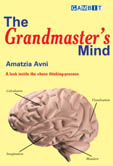|
|||||||||
Why is it important that Avni's psychology background plays such a large role in his writings? Why do I insist that you should be familiar with his column? Well it's like this - to paraphrase that famed baseball philosopher Yogi Berra, chess is 90% mental, and the other half is knowledge and ability. Perhaps the greatest challenge for most players is controlling their thoughts and emotions during the game, and training their mind to focus on the things that matter, rather than things that don't. Avoiding these mental mistakes is the fastest way to improve your results the most, and that's why Avni's writings are so important. These aren't the sort of tips you might expect to find, and not the sort you find in most improvement books. Avni doesn't teach you tactics, he teaches you how to avoid, e.g., the psychological collapse that protracted defense can lead to, and the subsequent blunders. He doesn't teach you grand strategical concepts, he teaches you where to focus your thinking time to provide the greatest benefit. Avni's teachings and advice help form the mind into a weapon in it's own right. That's why his work is so important to the development of a chessplayer. His latest effort, Chess Tips for the Improving Player, is not for the beginning player, but rather the club player who wants some, as the title says, practical tips to improvement. A quick look at the sorts of topics covered, as revealed in the various chapter titles, should give you some idea of what's in store for the reader:
Chapter Four alone is probably worth the price of the book, providing guidance in areas like: The Principle of Economy, Solidity Outweighs Tricks, Concessions are Part of the Game, Forced Moves are Not Always Forced, etc. As the title implies, this book contains practical information, stuff you can put to use immediately in your games. Tips you can read today and use tomorrow to win more games, improve your rating, and most importantly, to understand and enjoy your chess even more. I get ahead of myself though, so let's back up and start at the beginning, as Avni does. First, a word or two about the production values. As with all of their titles, the publisher, Quality Chess, have produced a well-crafted book. Clean bright pages, with plenty of white-space (without wasting massive amounts of space) combine with diagrams that are easy to see and study. You can see this clearly in the excerpts provided below in the pdf file. A slick, glossy cover shows off some interesting artwork, but the less-than-perfectly glued binding leaves me wondering how long the cover would survive a really intensive amount of use. Hopefully long enough. After a brief introduction and some acknowledgements, Avni, in Chapter 1, launches into a discussion of the chess board. Sure, it has 64 squares, but as Avni points out, "...in any given position, they are seldom all relevant at the same time." In the space of half a page, Avni hints at the issues he will address in the coming pages: Look for the key, Give me an entry point; Identifying the critical path; Clear the Critical path; Cross the equator; The vulnerability of fortified zones; and lastly, Black and White are different creatures. That last ought to catch the attention of another occasional Chessville contributor - GM András Adorján, he of Black is OK! fame. Avni, acknowledging the debate, presents insights from GMs Rowson and Sveshnikov. GM Sveshnikov, Avni writes, "has presented a refined set of opening principles. Interestingly, he assigns different weights to his principles, according to a player's color." That is a debate outside the scope of this review though, so let's go back to "Give me an entry point" and see just how Avni illustrates this idea. Avni writes: "We classify positions as 'closed' or 'open' in accordance with the pawn structures. Many players are unaware of the suddenness with which a closed position may open. A tiny defect in an otherwise solid configuration may be exploited by an adroit adversary as an entry point for further action." In keeping with the theme of "practical" that I mentioned above, Avni uses real game positions to illustrate the many ideas, not some made-up position that you're unlikely to ever see: Reshevsky-Kavalek
White to play
An excellent example:
Jumping ahead, as I must (there's simply too much material in this book to even attempt to cover it all in a review), to Chapter 5, "In Search of Ideas", Avni writes:
Been there, done that - an all-too-common situation to find oneself in. So, what tips does Avni offer to the aspiring player? From the introduction to this chapter: Familiar position, different treatment; Experimenting; Blending ideas; Exploit your opponent's ideas; Saving an imperfect idea; Good idea, wrong timing; Borrow ideas; Look for ideas in the garbage can; Challenge your assumptions; and finally, If you build it, he will come. Don't be misled by the casual-sounding nature of some of these ideas (The garbage can? Really?) There is plenty of wisdom in each of these short (typically 2-3 pages each) sections. One advantage for the student is that study of the book, because of the relatively short sub-sections, can be approached like a buffet: take what you like, leave what you don't. Graze to your heart's content, and come back as often as you'd like. Or need. Let Avni speak for
himself though - read the excerpts in the PDF file below - and then BUY THIS
BOOK! It will be money well spent, and I can't think of another title
of recent vintage that will provide more immediate benefits for the class
player who seriously wants to play better and win more games.
|
The
Advertise to Single insert:
|
||||||||
|
|||||||||













